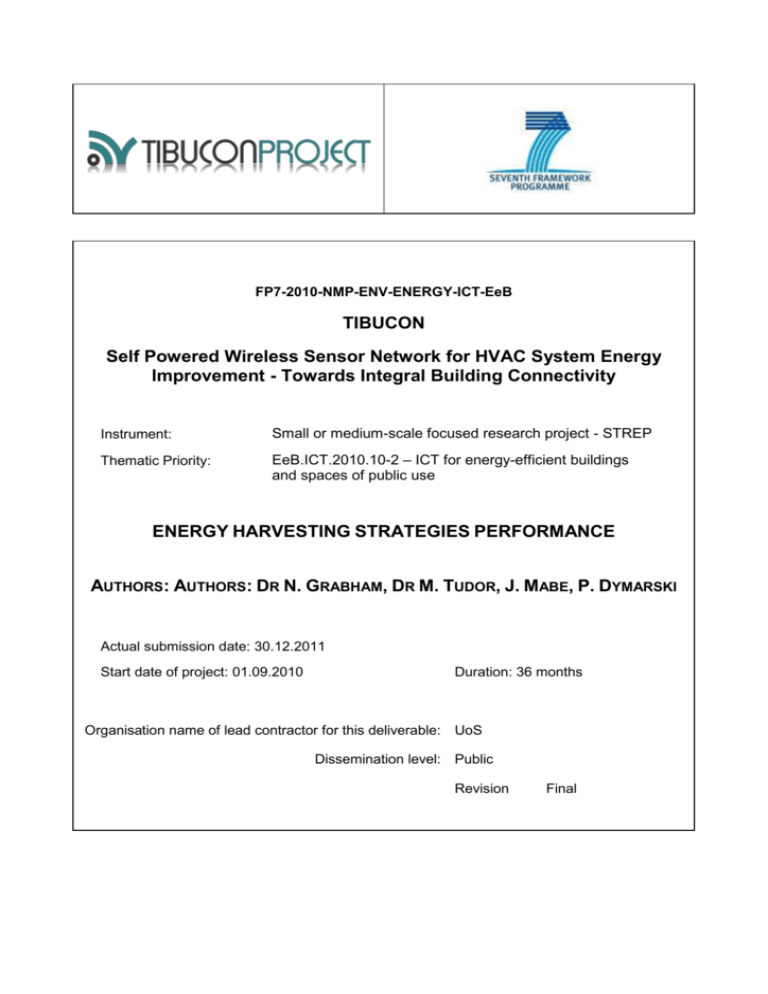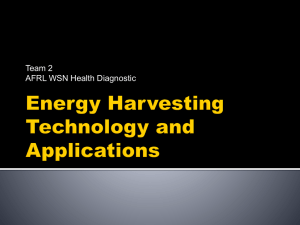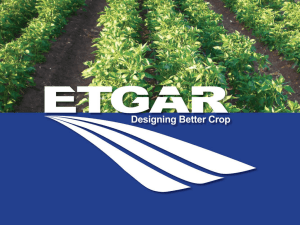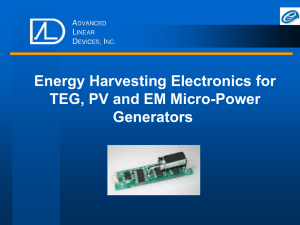Energy harvesting strategies performance
advertisement

FP7-2010-NMP-ENV-ENERGY-ICT-EeB TIBUCON Self Powered Wireless Sensor Network for HVAC System Energy Improvement - Towards Integral Building Connectivity Instrument: Small or medium-scale focused research project - STREP Thematic Priority: EeB.ICT.2010.10-2 – ICT for energy-efficient buildings and spaces of public use ENERGY HARVESTING STRATEGIES PERFORMANCE AUTHORS: AUTHORS: DR N. GRABHAM, DR M. TUDOR, J. MABE, P. DYMARSKI Actual submission date: 30.12.2011 Start date of project: 01.09.2010 Duration: 36 months Organisation name of lead contractor for this deliverable: UoS Dissemination level: Public Revision Final TIBUCON Energy Harvesting Strategies Performance Introduction The purpose of this study is to assess the amount of ambient energy available in domestic and commercial environments that can be harvested using a selected range of energy harvesting technologies. Energy Harvester Types Three primary harvesting technologies were considered for use in the TIBUCON project and these are: Photovoltaic Energy Harvesters: These are a well-established, mature, technology. Specific modules are available that are optimized for indoor use, with their operational wavelengths optimized for operation under artificial lighting. These devices will also operate satisfactorily under the lower illumination levels to be anticipated in an indoor environment, as compared to those to be anticipated if the solar module was deployed outdoors in direct sunlight. An example of an outdoor specification solar module is shown in Figure 1. Figure 1 – External Specification Solar Module Thermoelectric Energy Harvesters: These harvesters are based upon the Seebeck effect, whereby a temperature gradient across the device provides the energy for the device to operate. Typical placement of such devices is anticipated to be on the HVAC radiators and pipework, with the temperature difference between these surfaces and the ambient air temperature providing the required thermal gradient. Specific energy harvesting devices are now available which are optimized for use as harvesting modules as opposed to the first generation Peltier cooling elements, which can be used for harvesting purposes but which are optimized for cooling operation. An example of a bulk material thermoelectric energy harvester is shown in Figure 2, an example of a thermal energy harvesting device using a micro-fabricated thermoelectric harvester is shown in Figure 3. Page 2 of 5 TIBUCON Energy Harvesting Strategies Performance Figure 2 – Bulk Thermoelectric Energy Harvesting Device Figure 3 – Energy Harvesting Node with Micro-Fabricated Thermoelectric Harvesting Device Vibration Energy Harvesters: Commercially available energy harvesters fall into three modalities: piezoelectric, electromagnetic and electrostatic. Of these three modalities only piezoelectric and electromagnetic based harvesters have been developed to commercially available devices and are therefore suitable for consideration in this project. The main limitation of the available units is that the level of energy that can be harvested is highly dependent on the frequency of the exciting vibration due to the resonant mode of operation employed by these harvesters. An example of a piezoelectric-based vibration energy harvester is shown in Figure 4. Figure 4 – Piezoelectric-based Vibration Harvester In addition to the three main harvester technologies that are outlined above less well established and emerging technologies were also considered for their use within the scope of this project. These devices had limited potential for deployment within the target environments due to the lack of suitable ambient source energy, or had a device cost which was incompatible with the financial targets required to permit deployment of a large number of sensor nodes. Page 3 of 5 TIBUCON Energy Harvesting Strategies Performance Available Energy Sources within Deployment Environments The TIBUCON project aims to produce sensor nodes that can be deployed into two main environments: residential properties and office spaces. To this end, surveys of the available ambient energy sources and the typical levels of these sources were performed for both residential and office locations. Residential Environment: Surveys of the available ambient energy were performed for a number of residential apartments located in San Sebastian, Spain. These measurements were concentrated on the main living space as this is the target location for the TIBUCON sensors. Within the apartment living room areas the main ambient energy sources are solar and thermal energy. There is a lack of significant airflows for wind energy harvesting and vibration for vibration harvesting. Within the main living spaces the ambient light levels at the approximate midpoint of the side walls ranged from 70 to 200 lux in rooms with normal lighting levels, within the darker rooms these levels reduced to around 40 lux, In all cases close to the exterior windows provided illumination levels in excess of 1000 lux. The use of the HVAC radiators and associated pipework as a heat source for thermal harvesters does however have the limitation that these are only heated during the periods of time that the space heating is active, which for the test site is from 12 noon to 10pm daily between the dates 1st of October and 15th of May. Office Environment: Surveys were performed in a range of indicative office buildings, with the primary emphasis on office space, as opposed to plant areas. Within the occupied office spaces surveyed the main source of available ambient energy is solar, with some locations having exposed HVAC radiators which could be used as heat sources for thermal energy harvesters however this is limited by the fact that the HVAC radiators are likely to only be active through part of the year. In common with the residential spaces surveyed there is a lack of significant airflows for wind energy and vibration for vibration harvesting. Some airflow may be present during periods when the air conditioning is active but strong airflows are typically avoided for occupant comfort with diffusers used. A further factor in favour of using solar energy harvesting within the office environment is that offices are typically well lit to suit the tasks being carried out within them and to maximise occupant alertness, within the office spaces there were typically illumination levels of 200 lux and above available in the surveyed locations. Some locations had areas with lower illumination levels but in general this was due to positioning of furniture causing areas to be blocked from the natural and artificial light sources. In the majority of the office spaces, locations were available with illumination levels of 500 lux and greater. This level of illumination is attributable to the level of lighting specified for office working environments. Page 4 of 5 TIBUCON Energy Harvesting Strategies Performance Selected Energy Harvesting Technologies The most applicable energy harvesting technology for nodes across both deployment environments has been found to be solar energy harvesting and a range of commercially available photovoltaic modules have been identified which are optimised for operation under low level artificial lighting conditions. It is anticipated that all the energy harvesting sensor nodes will be equipped with indoorspecification solar modules as their primary energy harvesting technology. There are however some further options for alternative energy harvesting technologies within specific locations. Within the residential retrofit environment, and also in some of the surveyed office buildings, there is the potential to deploy thermal energy harvesters as a secondary energy source where there are suitable heat sources. In most cases these heat sources are HVAC pipework and radiators, though in the case of pipework etc. associated with space heating it is to be anticipated that the heat sources will only be available for parts of the day during applicable seasons and not available at all during seasons when the space heating is inactive. Where external sensor and/or routing nodes are required it is possible to add a secondary harvesting module containing an externalspecification solar module which will provide a larger energy budget than that provided by the indoor-specification Page 5 of 5







